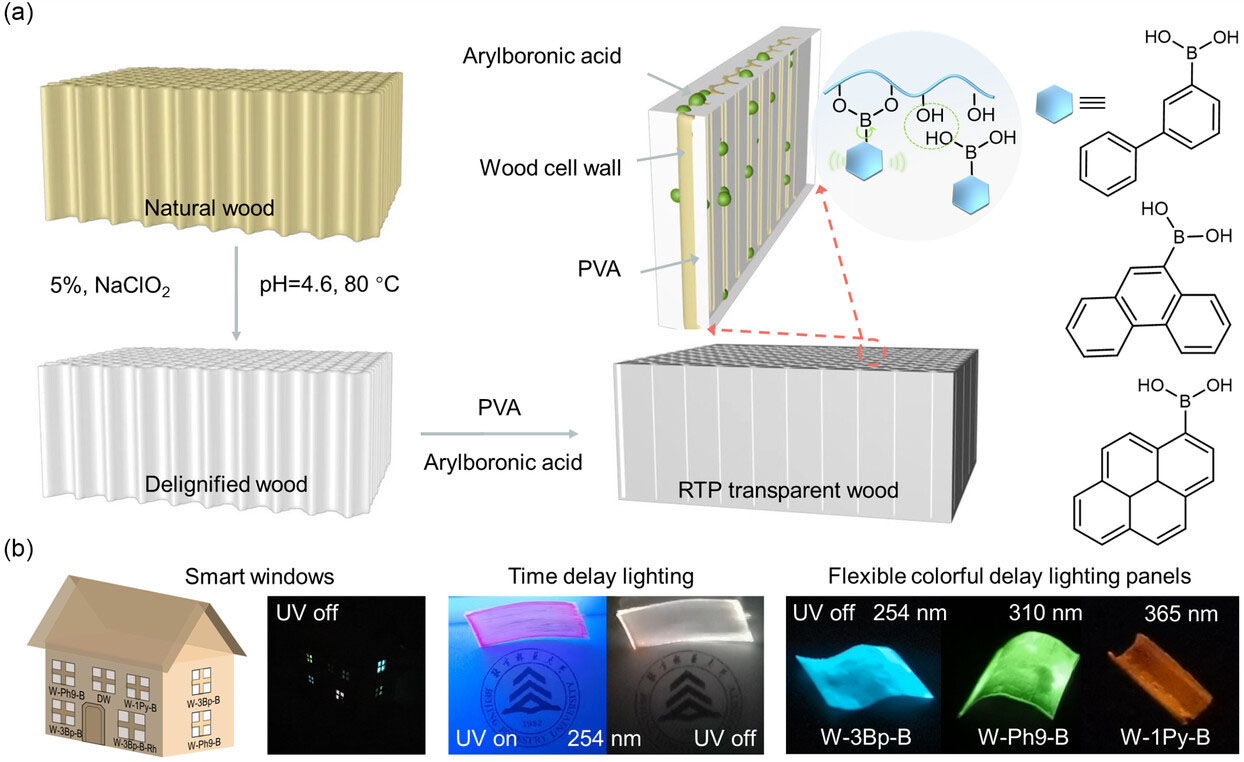| Mar 07, 2024 |
|
|
|
(Nanowerk Spotlight) In the quest for sustainable and multifunctional materials, wood has emerged as a prime candidate due to its unique combination of strength, durability, and renewability. However, despite its many desirable properties, wood has long been hindered by its opacity, limiting its potential applications in fields such as energy-efficient buildings, solar cells, and light-emitting devices.
|
|
To overcome this limitation, researchers have developed various strategies to render wood transparent while preserving its mechanical integrity, a process that typically involves removing the light-absorbing lignin component and replacing it with a transparent polymer matrix.
|
|
While transparent wood itself represents a significant advancement, the ability to imbue it with additional functionalities, such as room-temperature phosphorescence, has remained a challenge. Room-temperature phosphorescence, the emission of light that persists after the excitation source is removed, has numerous potential applications, including emergency signage, anticounterfeiting labels, and decorative lighting. However, most materials that exhibit this phenomenon are inorganic or organometallic compounds, which can be expensive, toxic, and difficult to process. Organic compounds, on the other hand, often suffer from weak emission and short lifetimes due to inefficient intersystem crossing and non-radiative decay pathways.
|
|
In an effort to address these limitations, researchers have explored various strategies to enhance the room-temperature phosphorescence of organic materials, such as crystal engineering, host-guest complexation, and polymer matrix encapsulation. While these approaches have yielded promising results, they often require complex synthesis, precise control over the molecular arrangement, or the use of expensive and rare metal ions. Moreover, the integration of these phosphorescent materials into practical, large-scale applications has remained a significant challenge.
|
|
Recent advancements in the field of organic electronics have provided new insights into the design and synthesis of efficient and stable organic phosphors. In particular, the use of rigid, π-conjugated structures with heavy atoms or carbonyl groups has been shown to enhance intersystem crossing and reduce non-radiative decay. Additionally, the incorporation of these phosphors into polymer matrices with high glass transition temperatures and low oxygen permeability has been found to improve their stability and performance under ambient conditions.
|
|
Building upon these developments, a team of researchers from Beijing Forestry University and South China University of Technology has now taken a significant step forward by successfully integrating organic phosphors into transparent wood, creating a new class of sustainable, multifunctional materials with tunable, long-lived room-temperature phosphorescence. Their innovative approach, which involves the covalent bonding of arylboronic acids to the cellulose fibers and polyvinyl alcohol matrix within the wood structure, not only overcomes the limitations of previous organic phosphors but also leverages the unique properties of wood to enhance the optical and mechanical performance of the resulting material.
|
 |
| Schematic illustration of the room-temperature phosphorescence transparent wood (PTW). a) Preparation of the PTWs and chemical structures of different arylboronic acids. b) Photographs of multicolor smart afterglow windows, time delay lighting panels with white afterglow, and flexible colorful delay lighting panels made of various PTWs. (Reprinted with permission by Wiley-VCH Verlag)
|
|
The research has been published in Small Structures (“Colorful Room-Temperature Phosphorescence Including White Afterglow from Mechanical Robust Transparent Wood for Time Delay Lighting”).
|
|
The key to the success of this approach lies in the formation of covalent bonds between the boron atoms of the arylboronic acids and the oxygen atoms of the polyvinyl alcohol and cellulose fibers. These B-O bonds serve two critical functions: they anchor the phosphorescent molecules to the wood structure, preventing them from leaching out over time, and they create a rigid and dense network of hydrogen bonds that suppresses molecular motions and stabilizes the triplet excitons responsible for phosphorescence. By carefully selecting arylboronic acids with different π-conjugated structures, such as biphenyl, phenanthrene, and pyrene, the researchers were able to fine-tune the color of the phosphorescence from blue to green to red, with lifetimes ranging from 0.21 to 2.13 seconds.
|
|
The transparent wood samples produced using this method exhibited remarkable optical and mechanical properties. The transmittance values reached up to 90%, making the material highly transparent, while the tensile strengths reached up to 154 MPa, far surpassing those of most polymers and plastics. This combination of optical clarity and mechanical robustness is a significant breakthrough, as it opens up new possibilities for the use of wood-based materials in applications that require both transparency and strength, such as energy-efficient windows, solar cells, and flexible displays.
|
|
Another impressive achievement of this work was the generation of white-light phosphorescence by doping a blue-emitting transparent wood sample with a small amount of the red-emitting dye rhodamine 6G. Through a process known as Förster resonance energy transfer (FRET), the triplet excitons of the arylboronic acid donor efficiently transferred their energy to the singlet excited state of the rhodamine 6G acceptor, resulting in a balanced mixture of blue and red emission that appeared white to the eye. This white-light-emitting transparent wood had a phosphorescence lifetime of 1.85 seconds and a color coordinate close to that of standard white light, making it particularly attractive for applications in solid-state lighting and displays.
|
|
To demonstrate the practical potential of their phosphorescent transparent wood, the researchers fabricated several proof-of-concept devices, including smart windows that could provide ambient lighting after being exposed to sunlight during the day, time-delay lighting panels that could serve as emergency signs or decorative elements, and anticounterfeiting labels that reveal hidden patterns when the excitation source is removed. These demonstrations highlight the versatility of the material and its potential to be integrated into a wide range of products and systems, from building materials to consumer goods.
|
|
While the development of phosphorescent transparent wood represents a significant milestone, there are still some challenges that need to be addressed to further enhance its performance and broaden its applicability. For example, improving the efficiency and brightness of the phosphorescence, extending the lifetime even further, and expanding the range of emission colors and color-mixing strategies could make the material even more attractive for practical applications. Additionally, the long-term stability and performance of the phosphorescent transparent wood under different environmental conditions, such as high humidity, extreme temperatures, and UV exposure, need to be carefully evaluated to ensure its durability and reliability.
|
|
Despite these challenges, the work by the Beijing Forestry University and South China University of Technology team demonstrates the vast potential of wood-based materials to address the growing demand for sustainable, high-performance, and multifunctional technologies. By combining the inherent advantages of wood with advanced chemical and physical functionalities, researchers are paving the way for a new generation of smart, eco-friendly, and versatile materials that could transform the way we live, work, and communicate.
|
|
As research in this field continues to progress, we can expect to see even more exciting developments in the near future. The integration of phosphorescent transparent wood with other emerging technologies, such as solar cells, sensors, and electronic devices, could lead to the creation of truly multifunctional, energy-efficient, and intelligent materials that blur the boundaries between nature and technology. The potential impact of these innovations on fields ranging from architecture and transportation to healthcare and entertainment is immense, and it is clear that wood, a material that has been used by humankind for millennia, still has plenty of surprises in store for us.
|
|
The development of phosphorescent transparent wood represents a significant breakthrough in the field of sustainable and multifunctional materials. By leveraging the unique properties of wood and integrating them with advanced optical functionalities, researchers have created a new class of materials that combine the best of both worlds: the strength, durability, and sustainability of wood with the transparency, phosphorescence, and tunability of organic phosphors.
|
|
While there are still challenges to be addressed, the potential applications of this technology are vast and exciting, ranging from energy-efficient buildings and smart windows to flexible displays and anticounterfeiting labels. As research in this field continues to progress, we can expect to see even more innovative and transformative developments that push the boundaries of what is possible with wood-based materials.
|
|

By
Michael
Berger
– Michael is author of three books by the Royal Society of Chemistry:
Nano-Society: Pushing the Boundaries of Technology,
Nanotechnology: The Future is Tiny, and
Nanoengineering: The Skills and Tools Making Technology Invisible
Copyright ©
Nanowerk LLC
|
|
|
- SEO Powered Content & PR Distribution. Get Amplified Today.
- PlatoData.Network Vertical Generative Ai. Empower Yourself. Access Here.
- PlatoAiStream. Web3 Intelligence. Knowledge Amplified. Access Here.
- PlatoESG. Carbon, CleanTech, Energy, Environment, Solar, Waste Management. Access Here.
- PlatoHealth. Biotech and Clinical Trials Intelligence. Access Here.
- Source: https://www.nanowerk.com/spotlight/spotid=64810.php





